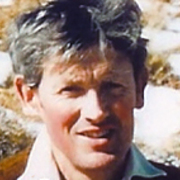
Conon Fraser
New Zealand television viewers first encountered Conon Fraser as presenter of the weekly NZBC programme The World Around Us in June 1964. The 10-minute programme, which he also wrote, was aimed at school-age children and gave viewers a background to the news using films, maps and pictures. It screened on Mondays until December 1965.
Before joining the NZBC Fraser had been a freelance writer. He was born in Cambridge, England, and educated at Marlborough and the Royal Military Academy, Sandhurst. In 1951 he resigned his commission in the Royal Artillery and worked as a writer. His output included adventure stories for boys and a book on Captain Cook. He came to New Zealand in 1958.
From May to December 1966 Fraser produced a new programme, Pictorial Magazine, dealing with facets of the New Zealand way of life, which took viewers to all parts of the country. Screened in a Sunday night primetime slot it grew in popularity. After a Christmas holiday break the magazine programme re-appeared with a new title — Looking at New Zealand.
Early programmes were usually made up of two- or three-minute snippets, so it was unusual for the contents of an individual programme to be publicised. Such was the programme’s success that it was sufficient to advertise the programme’s title alone to attract and hold its audience.
As producer, Fraser was Wellington-based and did not travel as extensively as the programme’s contents may have suggested. It was estimated that some 60 per cent of film shot for Looking at New Zealand was the work of "stringers" — freelance cameramen that the NZBC had stationed all over the country, equipped with a 16mm camera and a supply of film, and ready to race off to film local events or news items as required.
Along with items that took a leisurely look at holiday spots, there was the occasional thrill. Visiting Denniston in early 1967 with cameraman Pierre Lods, Fraser rode the hair-raising incline not long before its closure.
Beverley (future Chief Ombudsman) Wakem became Fraser's production assistant, and Iain McLean was director for many of the longer items. As time went on production resources grew and single-subject programmes became more common. The first programme of 1968, sub-titled The Third Island, dealt with Stewart Island and was directed by Derek Morton.
The last Looking at New Zealand programme to be made by Fraser was broadcast on Sunday December 15, 1968. It had as its subject the Tuhoe people of the Urewera, the “children of the mist”. In February 1969, Fraser joined the National Film Unit as a Unit Director.
Although the NZBC continued to make Looking at New Zealand for another year, the publication of Fraser’s 1969 book of the same title cemented his association with the series he had made so popular.
In one of his first films for the NFU, The Oyster Men, he was able to develop his documentary film making skills, free from the demands of a weekly schedule and with the big screen in mind. Tongariro Power (1970), made for theatrical release, was his first colour film.
On most films he was writer and director, but he also worked on three programmes of the NFU’s series for television The Years Back as researcher and editor.
In Children of the Mist (1974), he tackled in greater depth a subject that had featured in his last Looking at New Zealand programme. The new film was in 35mm colour and went on circuit with the feature Games 74.
Among other films he directed were the educational films Arteries of Power, and The Erosion of Our Land, and further shorts for theatrical release such as The Kauri and Coal Valley. The latter won, among other awards, a Mitra Award of Honour at the 26th Asian Film Festival in 1980.
When the decline in demand for theatrical short films left television as the principal outlet for NFU films, he wrote and directed Off The Ground, a three-part series dealing with the history of aviation in New Zealand.
Also for television release were Tarawera (1986), a dramatised documentary marking the centenary of the destructive eruption, and Beyond The Roaring Forties - The Story of New Zealand's Sub-Antarctic Islands (1986). His book of the same title was published to coincide with the screening of the latter film.
Retiring from the NFU in 1986, he pursued his interest in the outdoors and continued to write, including a book on the Enderby Settlement of the Auckland Islands for Otago University Press. Fraser died on 17 June 2014, aged 84.
Writing and Original Research by Clive Sowry
Sources include
Conon Fraser
Conon Fraser, Beyond The Roaring Forties – New Zealand's Sub-Antarctic Islands (Wellington: Government Printing Office Publishing, 1986)
Lynne Walsh, ‘Much-praised film on coalminers was no picnic for NFU’ – Evening Post, August 20, 1980, page 17
Conon Fraser, Looking at New Zealand (Christchurch: Whitcombe & Tombs Limited, 1969)
‘Children of the Mist’ – New Zealand Listener, Vol. 59 No. 1522, December 6, 1968, page 4
‘Notebook – Television” – New Zealand Listener, Vol. 59 No. 1504, August 9, 1968, page 26
‘Our Way of Life’ – New Zealand Listener, Vol. 53 No. 1367, December 17, 1965, page 28
‘People – The Writer and His World” – New Zealand Listener, Vol. 51 No. 1297, August 7, 1964, page 10.